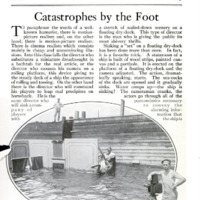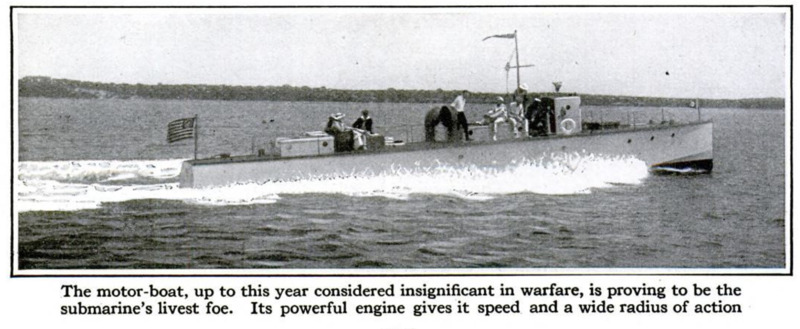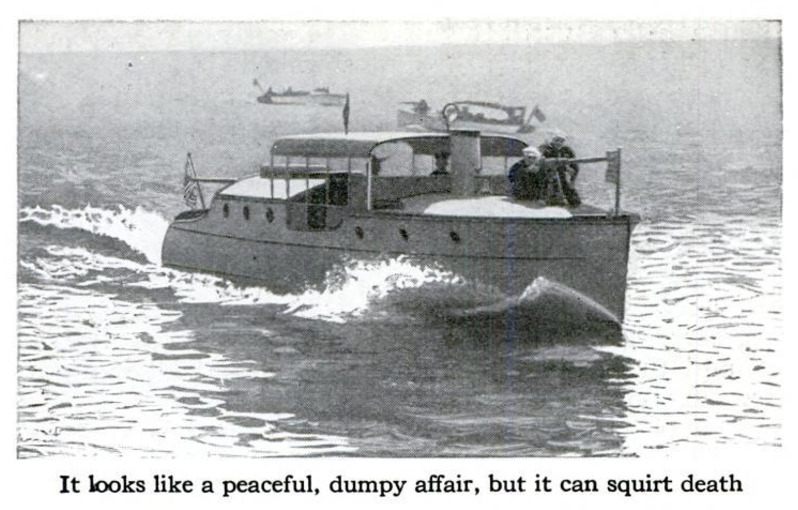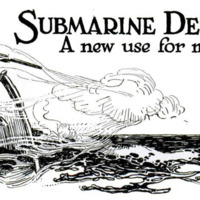-
Title (Dublin Core)
-
Submarine Destroyers. A New Use for Motor Boats
-
Article Title and/or Image Caption (Dublin Core)
-
Submarine Destroyers. A New Use for Motor Boats
-
Caption 1: The motor-boat, up to this year considered insignificant in warfare, is proving to be the
submarine's livest foe. Its powerful engine gives it speed and a wide radius of action
-
Caption 2: It looks like a peaceful, dumpy affair, but it can squirt death
-
Caption 3: Equipped with wireless it cuts
through the water and rides safely over mine fields
-
extracted text (Extract Text)
-
Srrens sleep peacefully in their
berths on the freighters lying in the
Thames near London in spite of sub-
marine warfare. Freight from America
and other countries, munitions of war
and food supplies, arrive there in such
quantities that the boats cannot be
unloaded immediately, but they are
just as safe in the mouth of the Thames
as they would be in New York harbor.
For that, England has America and
Russia to thank. Some enterprising
Russian must have seen Flyaway III
winning races in American waters; there
is the secret of the safety of commerce in
the mouth of the Thames.
What keeps the German submarine
away is the huge fleet of pert, saucy,
little American launches. All of them
were developed from the lines of Flyaway
111, one of the few new engines of war
for which America is responsible. Each
boat is sixty feet long and is driven
thirty miles an hour by gasoline engines.
“Submarine swatters,” the boys down
on Long Island, New York, nicknamed
them before they were shipped. With
supplies of food and fuel for several days’
cruise these boats spread fanlike from
the mouth of the Thames, and from
other shipping centers in England and
Russia on the lookout for the wily
submarine whose evil eye trails a fail of
oil and bubbles behind it. In the
deck house of the submarine swatter is
a three-pound quick firer, capable of
knocking the periscope clean off, or
mortally wounding the submarine before
it can come to the surface and get into
action against the little American
launches. No submarine can sail any
waters where these fleets are located for
half a day without being spotted, trailed,
and destroyed. As was said before, the
skippers of the freighters in the mouth
of the Thames, waiting for a chance to
unload, sleep peacefully on.
A trial order of these submarine
swatters was given to a Greenport, L. I.,
construction company late last year, and
shortly afterward six were shipped to
Archangel, before that Russian port
closed for the winter. Great secrecy
was maintained as to the details, but
after the second order was given, proving
in the only way possible that the boats
were successful, general specifications
were admitted.
Each boat carries three 175-horse-
power engines, giving a total of 525
horsepower to drive the load. The speed
called for was twenty-six miles an hour,
but the average, on the trials which
could be held, was over thirty miles.
The boats are sixty feet long, ten feet
beam, and two feet ten inches draft.
They weigh twenty-eight thousand
pounds. There are accommodations for
eight men, six
bunks forward
and two aft, the
latter for the
engineers. The
pilot house,
which is practi-
cally the only
obstruction on
the deck, is
armored and has room
for a quick firer, which
of course was not
mounted before the
boats were shipped to
Russia.
The boats are of the
V-type, a design which is
but a year or two old in
American motor-boats.
The bow is sharp, but
a few feet back is a
shoulder on each side of
the hull, which performs
the same duty as the
steps on a hydroplane,
and lifts the hull partly
out of the water. The first large boat
of this design which was completely
successful was the famous champion
racing cruiser Flyaway III, which is still
champion. Were the new Russian sub-
marine swatters to compete with Fly-
away, a new winner would probably
be announced. They are much larger,
faster boats, in fact, the largest V-type
ever constructed, and it is the success
of this development which has so inter-
ested Americans.
As fighters, these motor-boats should
be efficacious against submarines. They
draw so little water that they can ride
safely over the ordinary mine-fields with-
out exploding the mines. They are’
equipped with two rudders so that they
can turn completely around in a little
more than their own length, and hence
can steer a violent zig-zag course. A
submarine attempting to torpedo such
a boat, traveling thirty miles an hour
with so little hull to shoot at, would be
attempting almost the impossible.
In realizing the tremendous advance
of the motor-boat it must be remembered
that these vessels can travel at high
speeds, in almost any seaway, carrying
eight men for long distances, and that
they are armed in addition. A few
years ago motor-boats did not travel so
fast with one man, for a mile only, even
on quiet, inland waters. And yet they
are small enough to be placed on the deck
of a warship. This is evidenced by the
fact that each is equipped with cleats,
bolted to the keel, by which it can be
lifted from the water. This is the reason
England has placed a very large order
for duplicates of this American design.
-
Language (Dublin Core)
-
eng
-
Date Issued (Dublin Core)
-
1916-08
-
pages (Bibliographic Ontology)
-
180-182
-
Rights (Dublin Core)
-
Public Domain (Google digitized)
-
Archived by (Dublin Core)
-
Filippo Valle
-
Alberto Bordignon (Supervisor)
 Popular Science Monthly, v. 89, n. 2, 1916
Popular Science Monthly, v. 89, n. 2, 1916









